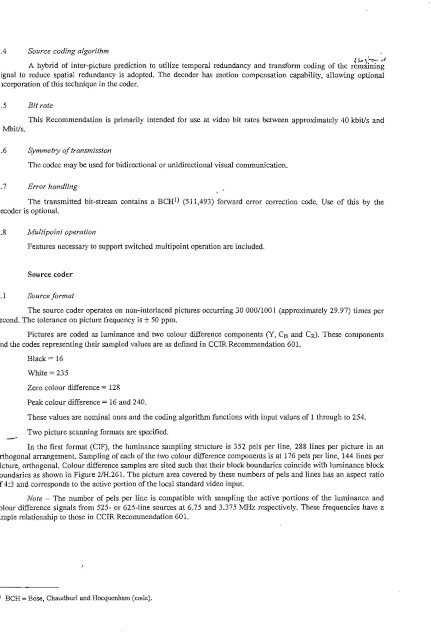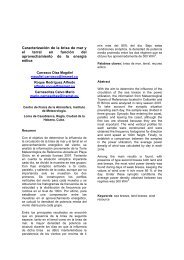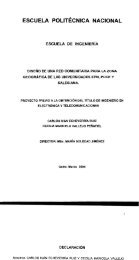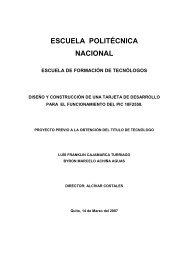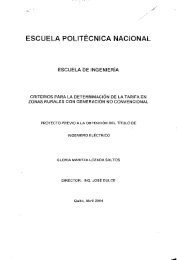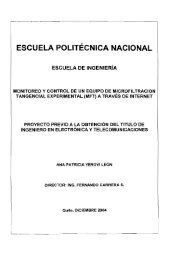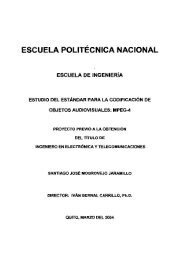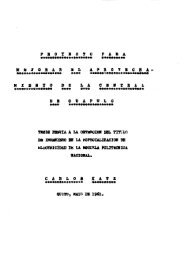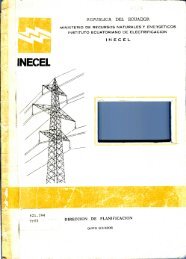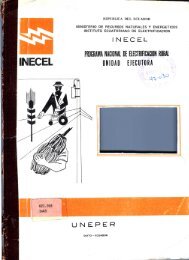Tesis previa a la obtención del Título de Ingeniero en Electrónica y ...
Tesis previa a la obtención del Título de Ingeniero en Electrónica y ...
Tesis previa a la obtención del Título de Ingeniero en Electrónica y ...
Create successful ePaper yourself
Turn your PDF publications into a flip-book with our unique Google optimized e-Paper software.
,4 Source codirig olgorithm<br />
. . ,, *TÍ-«^*^T~ ^<br />
A hybnd of inter-picture prediction to uühze temporal redundancy and transform coding of the remaining<br />
ignal to reduce spatial redundancy is adopted. The <strong>de</strong>co<strong>de</strong>r has motion comp<strong>en</strong>sation capability, allowing optional<br />
icorporation of this technique in the co<strong>de</strong>r.<br />
.5 Bitrate<br />
This Recomm<strong>en</strong>dation is primarily int<strong>en</strong><strong>de</strong>d for use at vi<strong>de</strong>o bit rates betwe<strong>en</strong> approximately 40 kbit/s and<br />
Mbit/s.<br />
.6 Symmetry oftronsmission<br />
The co<strong>de</strong>e may be used for bidirectional or unidirectional visual communication.<br />
.7 Error handlmg<br />
The transmitted bit-stream contains a BCH1) (511,493) ibrward error correction co<strong>de</strong>. Use of this by the<br />
eco<strong>de</strong>r is optional.<br />
.8 Multipoint operation<br />
Features necessary to support switched rnultipoint operation are inclu<strong>de</strong>d.<br />
Source co<strong>de</strong>r<br />
.1 Source format<br />
The source co<strong>de</strong>r operates on non-inter<strong>la</strong>ced pictures occurring 30 000/1001 (approximately 29.97) times per<br />
econd. The tolerance on picture frequ<strong>en</strong>cy is ± 50 ppm.<br />
Pictures are co<strong>de</strong>d as luminance and two colour difíer<strong>en</strong>ce compon<strong>en</strong>ts (Y, CB and CR). These compon<strong>en</strong>ts<br />
nd the co<strong>de</strong>s repres<strong>en</strong>ting their sampled valúes are as <strong>de</strong>fined in CCIR Recomm<strong>en</strong>dation 601.<br />
B<strong>la</strong>ck = 16<br />
White = 235<br />
Zero colour differ<strong>en</strong>ce = 128<br />
Peak colour differ<strong>en</strong>ce =16 and 240.<br />
These valúes are nominal ones and the coding algoritiim functions with input valúes of 1 through to 254.<br />
Two picture scanning formats are specifíed.<br />
In the fírst format (CIF), the luminance sampling structure is 352 pels per Une, 288 Unes per picture in an<br />
rthogonal arrangem<strong>en</strong>t. Sampling of each of the two colour differ<strong>en</strong>ce compon<strong>en</strong>ts is at 176 pels per Une, 144 Unes per<br />
icture, orthogonal, Colour differ<strong>en</strong>ce samples are sited such that their block boundaries coinci<strong>de</strong> with luminance block<br />
oundaries as shown in Figure 2/H.261. The picture área covered by these numbers of pels and Unes has an aspect ratio<br />
f 4:3 and correspondí to the active portion of the local standard vi<strong>de</strong>o input.<br />
Note - The number of pels per Une is compatible with sampling the active portions of the luminance and<br />
olour differ<strong>en</strong>ce signáis from 525- or 625-line sources at 6.75 and 3.375 MHz respectively. These frequ<strong>en</strong>cies have a<br />
imple reíationship to those in CdRUecomm<strong>en</strong>dation 601.<br />
BCH = Bose, Chaudhuri and Hocqu<strong>en</strong>ham (co<strong>de</strong>).


